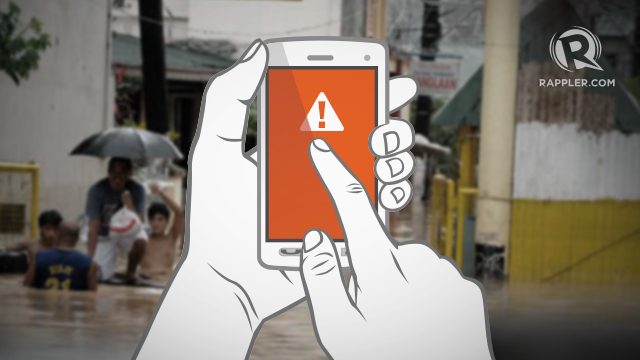SUMMARY
This is AI generated summarization, which may have errors. For context, always refer to the full article.

While Republic Act 10639 or the The Free Mobile Disaster Alerts Act has already been signed on June 20, 2014, its implementing rules and regulations (IRR) is still being reviewed. (READ: Free mobile alerts during disasters mandated)
RA 10639 mandates all telecommunications service providers (Telcos) to send free mobile alerts before disasters happen.
Representatives from the National Telecommunications Commission (NTC), Office of Civil Defense (OCD), National Disaster Risk Reduction and Management Council (NDRRMC), and major telcos in the country conducted its second public hearing on February 26 to review and discuss the IRR.
New cellphones and SIM cards?
Making the mobile alerts optional was one of the contentious issues discussed during the hearing.
Section 5 of the proposed IRR says those who are willing to receive alert messages should change their SIM cards to cell broadcast-compliant ones which will be produced by telcos in the country.
However, Telcos clarified this is not necessary because phones, even those made more than 15 years ago, have cell broadcast services but are turned off by default. This means that there is no need to replace SIM cards or even buy new phones.
OCD operations division head Col. Lt. Edwin Sadang agreed, noting the provision “defeats the purpose” of the law. The law seeks to make critical disaster information free and widely accessible to the public.
Cell broadcast is a system that has the capability to send messages to cellphones based on subscribers’ location to pre-arranged cell sites. It also enables location-specific alerts without the need to register cellular phones. Telcos said it is much faster than SMS broadcast, which is normally used for sending text messages.
Written proposals to remove this provision will be submitted to NTC by Monday, March 2.
A little late
The IRR is still being reviewed as of posting, almost 8 months after President Benigno Aquino III signed RA 10639. It was supposed to be submitted 60 days after the signing of the law.
The NTC has already approved the IRR but NDRRMC executive director Alexander Pama decided to review it again.
The NTC is mandated to ensure requests for cell broadcast of alert messages from agencies like NDRRMC and Phivolcs are sent by telcos.
When typhoons Ruby (Hagupit) and Seniang (Jangmi) hit the country in December 2014, the public complained they did not receive any alerts, according to Pama.
“I did get some inputs which I think might need some further validations and clarifications. So I got in touch with commissioner of NTC and we had a consensus that it may not be a bad idea for us to have a second look at these things [the IRR],” Pama explained.
He added the country has other ways to warn the public.
“When this [law] is going to be implemented, it will [just] fine tune or even strengthen our warning systems.”
Pama stressed the IRR should be hazards-specific, area-focused, time-bound, and cost-effective.
The final draft of the IRR will be signed mid-March, according to Sadang. – Rappler.com
Hands holding smartphone image from Shutterstock
Add a comment
How does this make you feel?





There are no comments yet. Add your comment to start the conversation.